Sargent’s Watercolors
There’s a week left to see the gorgeous exhibition at the Brooklyn Museum of seldom seen watercolors, “John Singer Sargent Watercolors” (the Brooklyn Museum is open from Wednesdays through Sundays), but if you can’t make it on such short notice, you will have another chance later this year, because it will be shown at the Boston Museum of Fine Arts, beginning October 1, 2013. (This is good news for those of you who like me are always finding themselves at the end of an exhibition’s run despite all past experience and good intentions.) Either way it’s worth making some effort to see this show (and braving the heat in New York City in order to get into the #2 train is some effort these days), because not only is it visually delightful, it will also probably dispel some misconceptions about Sargent and his place in Western art.
This exhibition is the kind of big show that has become infrequent recently, owing to insurance costs, increasing transportation risks, and maybe even reluctance of donors. By “big show” I mean not only one that has lots of items on display, but also one that shows an artist in a new light by comprehensively illustrating some aspect or period of his work. This one fits that definition and vividly demonstrates how watercolors can hold their own against oil painting for photographic-quality representation as well as for making bold, personal visual statements.
Watercolors are particularly apt to fade in light. That is the chief reason that the public at large has never seen these items. After the show these paintings will likely go back to storage. And despite the fact that many of works are available online and all can be seen in the exhibition’s excellent catalogue by Erica E. Hirshler and Teresa A. Carbone (with contributions by others), neither viewing can substitute for a close inspection of the originals, which will show the nature of the washes, the texture of the paper and where it was wetted, the layers of the paint, Sargent’s uses of opaque pigments and wax resists, his intentional scrapings, and most importantly his bold brushstrokes. The originals of watercolors differ much more from their reproduction in print, slides or other backlit renderings than do similar reproductions of oils because many of the pigments used in watercolors are translucent, a quality that cannot be captured by the other forms of publication. So this exhibition is literally a once in a lifetime opportunity to experience in full the bulk of a major phase of an artist’s career that is more written about than seen.
Provenance

Pomegranates by John Singer Sargent. (Watercolor on paper. 1908. Brooklyn Museum.) Click to enlarge.
This show represents the merging of two complete collections of watercolors selected by Sargent himself a century ago. One collection (owned by the Brooklyn Museum) came from Sargent’s first major American watercolor exhibition, which took place at New York’s Knoedler Gallery in 1909. Although Sargent had several times mounted highly successful watercolor shows in London, he was reluctant to undergo to the trouble and expense of boxing, shipping, insuring and clearing the works through customs. There would be no prospect of immediate financial rewards because Sargent, as a matter of principle, never sold his watercolors. Though he demurred, he nevertheless received continuous requests for a U.S. show, most persistently from his friend Edward Darley Boit. Boit was a Harvard lawyer who also had a specialty in watercolors. More importantly for our story, he had a wealthy father-in-law, the Boston nabob John Perkins Cushing who provided his daughter with a legacy sufficient to allow Boit and her to live the ex-patriot life while Boit painted in Paris. Sargent was there at the time and was commissioned to paint the couple’s four children. The result is visually stunning. But more, its formal structure, the way the children are posed, is so clever and the rendering of their facial expressions and carriage so perfectly natural that one can infer the moods of each child, their attitudes towards each other and their varying degrees of interest in the painter (or whatever else is attracting their attention in the direction of the viewer). It is one of the most emotionally satisfying portraits of Sargent’s career, because it conveys some sort of “truth” about the children beyond their appearance and allows the viewer to imagine a narrative. It suggests a story.

The Daughters of Edward Darley Boit by John Singer Sargent. (Oil on canvas. 1882. Museum of Fine Arts, Boston.) (Not in the Brooklyn exhibition.) Click to enlarge.
A quarter of a century after this commission, Sargent eventually came around to the idea of a New York watercolor show, motivated in part by a charitable impulse towards his friend, as he thought the exhibition would be a joint show with both his own and Boit’s watercolors. The gallery agreed, stipulating its standard commission, even though Sargent anticipated no sales.
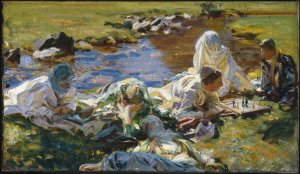
Dolce Far Niente by John Singer Sargent. (Oil on canvas. 1907. Brooklyn Museum.) This oil is in the Brooklyn exhibition and illustrates how Sargent’s relaxed watercolor portraits carried over to his oils, which no longer had the formal, dramatic look of his iconic portraits. This scene takes place in the Alps. Sargent’s manservant is the model for all three males in the painting.. (Click to enlarge.)
Evidently one of the first to see the 1909 show at Knoedler Gallery was Brooklyn Museum president Aaron Augustus Healy. Healy had long been an admirer of Sargent. Two years before the Knoedler show he sat for a formal portrait by Sargent. Healy had also recently purchased Sargent’s Dolce Far Niente (left). At the gallery he sensed an opportunity to strike a handsome bargain, and Healy quickly arranged an offer. The museum would pay $20,000 for the entire set of paintings. Sargent’s main objection to selling, it seems, was the belief that one watercolor was too ephemeral to stand alone. He regarded the collection as the work of art. Faced with an offer which burked this objection, Sargent agreed, and all 83 paintings went to Brooklyn. (Only about 50 of these paintings are in the Brooklyn collection and this exhibition, the museum having sold some of the items since the purchase.)
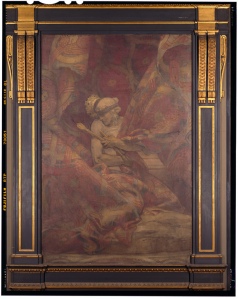
John Singer Sargent’s controversial Synagogue (before recent restoration), part of the “Triumph of Religion” series of murals at the Boston Public Library. Faced with objections to the supposed message that Judaism crumbled with the advent of Christ, Singer declined to complete the series with his planned Sermon on the Mount.
The Boston Museum of Fine Arts was caught flat-footed by the sale, which took place even before the exhibition made its way to Boston. Although Sargent was born in Florence (in 1856) and did not visit the United States until he was twenty (and spent little time thereafter), he always regarded himself as an American. (He declined George VII’s offer of a knighthood because he believed he would have to give up his U.S. citizenship to accept.) He considered Boston “home,” because his father’s family was one of the oldest New England families, dating back to colonial times. (Sargent’s grandfather, however, moved, when his shipping business failed, from Gloucester to Philadelphia, where Sargent’s father maintained a successful eye surgery practice before going abroad with his wife.) Out of loyalty to his claimed home, Sargent often undertook projects for Boston institutions or sold paintings to them at below market prices. Sargent underwrote his own expenses, for example, for two separate trips to the Middle East and North Africa to make studies for his famous “Triumph of Religion” murals at the Boston Public Library. In 1909 Sargent had hoped that the Museum of Fine Arts would bid on his collection. When he learned of their disappointment, he planned another exhibition of watercolors (also with Boit). All of the items selected for the second American exhibition he signed, anticipating a sale. The Museum of Fine Arts acquired the 50 watercolors even before they were exhibited in 1912. Those watercolors are also part of the present Brooklyn Museum exhibition.
With the combination of these two Sargent-selected collections the full power of his late career preference is made evident. Even a superficial survey affirms both the technical mastery and mature sensibility that Sargent brought to these works. And given his obsession with the reflection of bright light off surfaces (often white), the exhibition literally scintillates on the walls.
But does it change our view of Sargent?
Roger Fry and Sargent’s Reputation
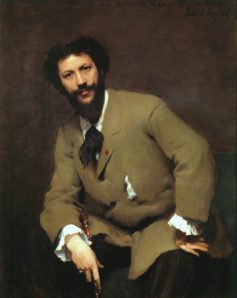
Portrait of Carolus-Duran by John Singer Sargent. (Oil on canvas. 1879. Sterling and Francine Clark Art Institute, Williamstown, Massachusetts.) Not in the Brooklyn exhibition. (Click to enlarge.)
Throughout his life Sargent’s raw technical ability made success effortless. He entered the École des Beaux-Arts on his first examination. He easily picked up the technique of his master, Carolus-Duran, of painting without underdrawing and quickly grasped Carolus-Duran’s concept (based on Velázquez) of visualizing a subject as an assemblage of planes of various shapes and colors and set at various angles to the canvas. The light thrown across the canvass would reflect on each plane, throwing additional light on to the other planes or showing them in relief. (For a simple illustration of this effect, see Mountain Fire above. In the oil portraits the technique is much more subtly rendered.) Being able to visualize this concept allowed for Sargent’s signature bold brushstrokes.
In 1877 Sargent, only 21, had his first painting accepted at the Paris Salon. He regularly thereafter exhibited there (including one in 1879 of Carolus-Duran), until the bourgeoisie, outraged by his Portrait of Madame X at the Paris Salon in 1879, chased him to London. In London he was by far the most sought after portrait painter of the era. Even before he moved here, Sargent received critical acclaim in England ever since his showing of Carnation, Lily, Lily, Rose (see below), although there was the underground murmur that it was too “French” for English tastes. When Sargent began showing his watercolors (private passion not for sale), he was again heralded. And when he moved to Boston for the last phase of his life, he was the lion of Boston’s art world.
In short, throughout his life he received almost universal critical acclamation and popular approval. But Sargent’s reputation went into eclipse after his death. And that was due almost exclusively to one man, British critic Roger Fry.
Roger Fry was one of the original Bloomsbury group of taste setters. Outside the art history world, he is known today mainly for being the subject of Virginia Woolf’s last book, an oddly defensive biography of her friend.

Facade of Chartres Cathedral by Roger Fry. (Watercolor on paper. 1906. Metropolitan Museum of Art.) Click to enlarge.
Fry was an early critic of Sargent, first of his watercolors. The Brooklyn’s exhibition’s catalogue notes that Fry’s early hostile opinion came with Sargent’s success at his first exhibition of watercolors at Carfax Gallery in London, May-June 1903. (The Metropolitan Museum of Art has the illustrated catalogue of that first show. Sargent would exhibit watercolors there again in 1905, 1906 and 1908.) Right before Sargent’s 1903 show, Roger Fry had a showing there (April 1903). For Fry the show was particularly noteworthy; it was his first solo exhibitions in any medium. He offered 34 watercolors. The works were conventional, detailed studies in pale washes typical of British watercolors of the day and are seldom reproduced today. The reviews were qualified, as they would be throughout his life. Virginia Woolf recorded his impressions of them:
All the critics, he complained, said the same thing; what the critic of the Westminster Gazette said may therefore be taken as an average sample. “Too strong a critical faculty and too wide an acquaintance with precedent are apt to act as a danger upon spontaneity. Sometimes we may suspect Mr Fry of thinking too much of his models and trusting too little to his instinct”—that was the usual verdict. (Virginia Woolf, Roger Fry: A Biography (NY: Harcourt, Brace and Co: c1940), p. 119.)
By contrast the reviews were glowing for Sargent’s work. Sargent’s watercolors of course were the antithesis of Fry’s. They were bold, colorful and breathed life. The Westminster Gazette (talking about the show at the Royal Society in 1904 with many of the same works) said that Sargent was “an eagle in a dove-cote.” Fry called Sargent’s works “crude.”
Fry’s hostility to Sargent, however, preceded the Carfax show. Again, Virginia Woolf:

Duke of Portland by John Singer Sargent. (Oil on canvas. 1901. Private collection?) (Not in the Brooklyn exhibition.) Click to enlarge.
[Fry] condemned [Sargent] instantly and unhesitatingly. “Mr Sargent”, he wrote in 1900, “is simply a précis writer of appearances.” Of his portrait of Lady Elcho, Mrs Adeane and Mrs Tennant he wrote, “Since Sir T. Lawrence’s time no one has been able thus to seize the exact cachet of fashionable life, or to render it in paint with a smartness and piquancy which so exactly corresponds to the social atmosphere itself. … He appears to harbour no imaginations that he could not easily avow at the afternoon tea-table he so brilliantly depicts.” The portrait of Sir Ian Hamilton made him exclaim, “I cannot see the man for his likeness”. And when he stood before Sargent’s portrait of the Duke of Portland he recorded his sensations in the following order: “First the collie dog which the Duke caresses has one lock of very white hair; secondly the Duke’s boots are so polished that they glitter; thirdly the Duke’s collar is very large and very stiffly starched; fourthly the Duke was when he stood for his portrait sunburnt. After that we might come to the Duke himself.” But by the time he came to the Duke himself is so “deadened by the fizz and crackle of Mr Sargent’s brush work that [he] can see nothing.” Whatever other judges might say, Sargent was to him nothing but a brilliant journalist whose work had no artistic value and would have no more permanent interest than the work of an expert photographer. (pp. 110-11)
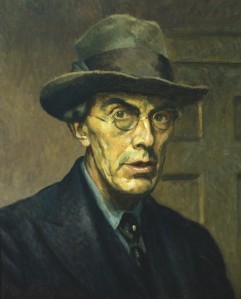
Roger Fry, self-portrait. (Oil on canvas. 1928. Private collection.) Not in the Brooklyn exhibition. Click to enlarge.
The irreversible break, however, came in 1910. In November Fry, now a full-throated modernist having been converted by Cézanne, organized a show at the Grafton Galleries, London, entitled Manet and the Post-Impressionists. A large number of viewers were greatly discomposed by the exhibit, their shock testifying to how insulated the English art scene was at the time. To rehabilitate public opinion and salvage the show, Fry advocated for the post-impressionists (a term he coined) in three pieces for The Nation. In the last of these, on December 24, 1910 (“The Post-Impressionists—II,” The Nation, vol. 8, p. 402 (December 3, 1910)), he overstated his case. Among the artists he claimed supported the goals of post-impressionism he listed Sargent. This drew not one, but two, open letters to The Nation, from Sargent (published in the January 7 and 14, 1911 issues). The first letter was particularly direct for a man as mild and refined as Sargent:
Mr. Fry has been entirely misinformed, and if I had been inclined to join in the controversy, he would have known my sympathies were in the exactly opposite direction as far as the novelties are concerned .… I have declined Mr. Fry’s request to place my name on the initial list of promoters of the Exhibition on the ground of not knowing the work of the painters to whom the name of Post-Impressionists can be applied; it certainly does not apply to Manet or Cézanne. … The fact is that I am absolutely sceptical as to their [the painters in the show other than Manet and Cézanne] having any claim whatever to being works of art … But one wonders what will Mr. Fry not believe, and one is tempted to say what will he not print?
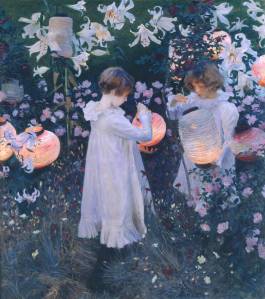
Carnation, Lily, Lily, Rose by John Sargent Singer. (Oil on canvas. 1885-86. Tate Britain.) Not in the Brooklyn exhibition. (Click to enlarge.)
Fry claimed he was unfazed by Sargent’s comments, but throughout his life he remained hostile to Sargent’s work and icy to Sargent personally.
Fry, for example, argued in Transformations that his and other critics’ initial raves were mistaken: the lily petals are “thin and tortured shapes” and the background a “lifeless green.” It is, he says, a “feeble echo” of Manet and his friends.
Shortly after Sargent died Fry wrote an acerbically malevolent review of the retrospective of Sargent’s works then showing at the Royal Academy. Fry acknowledged the English critics’ excitement when Sargent first arrived on the scene, but attributed it, rather implausibly, to their wonder that he could create so many works “with his own hand” (unlike Rubens, they supposedly said, who had numerous assistants). Fry then turns this feature against Sargent, proving he was no Rubens. To Fry Sargent’s facility came at the expense of his aesthetics. Sargent, he claimed, ceased looking at subjects like an artist who ought to strive for compositional balance, “adumbrations” of color harmony and a real interest “in the way contours flow.” Instead Sargent, according to Fry, launched himself by the end of the 1880s into a “world of imagery which is so fortunately unhampered by esthetic scruples.”
That, indeed, is the explanation of why he could produce so many works “with his own hand.” That hand was a highly trained and obedient servant of his eye, and his eye took in at a glance those salient facts of appearance out of which the average man builds his world; and, as he never felt tempted to probe sensation deeper for those other relations which only emerge for a disinterested and prolonged contemplation, there was nothing to check his unbounded energy; nothing to prevent him succeeding, as he did, every time.
We must abandon, then, this futile search for esthetic values in Sargent’s work—a search into which the misleading use of the word ‘artist’ has led us. Instead of demanding from him what it clearly was not in him to give, let us consider what it is that he does afford us. We must look at these pictures not as works of art with a value in and for themselves, but as illustrations or reports about other things. … The legend is that he had profound psychological insight into character, that he revealed this in all its nudity with a sublime indifference to social conventions. As far as this exhibition goes, this theory is hardly borne out.
It goes on and on like this. After repeating the evaluation in many iterations that “Sargent had neither the psychological nor the distinctively artistic vision” only “the undifferentiated eye of the ordinary man,” he concludes in what with these withering words wrapped in praise for Sargent’s gentlemanliness:
Certainly, in all that I have said in protest against the general opinion that Sargent was a great master I have never thought of the man himself with other than admiration. Although I did not know him personally, all I ever heard of him led me to believe him generous and self-effacing; I am sure that he was no less distinguished and genuine as a man than, in my opinion, he was striking and undistinguished as an illustrator and nonexistent as an artist. [“S. Sargent / As seen at the Royal Academy Exhibition of his works, 1926, and in the National Gallery” beginning at p. 126 of Roger Fry, Transformations: Critical and Speculative Essays on Art (London: Chatto & Windus: 1926)].
So against the weight of nearly all other critical judgment, Fry finds that Sargent was merely a photographer, who had neither psychological insight nor aesthetic vision, at least in any modern sense. That judgment has tended to stick to Sargent over the years, largely because Fry (thanks in great part to Virginia Woolf) has assumed the mantle as the successor to Ruskin.

Lady with the Rose (Charlotte Louise Burckhardt) by John Singer Sargent. (Oil on canvas. 1882. Metropolitan Museum of Art.) Not in Brooklyn exhibition. (Click to enlarge.)
Against Fry’s charge that Sargent had no ability to capture psychological nuance, however, Henry James stands. A more subtle observer of upper class psychology did not then exist. And though he became a close friend of Sargent, his verdict was unequivocal before that time. When he first saw Lady with the Rose, he was staggered: “It offers the slightly ‘uncanny’ spectacle of a talent which on the very threshold of its career has nothing more to learn. It is not simply precocity in the guise of maturity—a phenomenon we very often meet, which deceives us only for an hour; it is the freshness of youth combined with the artistic experience, really felt and assimilated, of generations.” It is of course no wonder that James marveled at the portrait: It describes visually the very kind of woman who James described with words. James saw his written portrayals to be a cognate art form to portraiture. And he recognized in Sargent exactly the kind of subtle psychologist that he himself was. The pose and expression tells a story of the woman, one that is hidden beneath the surface, only hinted at (but hinted it clearly is) by outward appearances. This is essentially the same story that James would tell of all his great women characters.
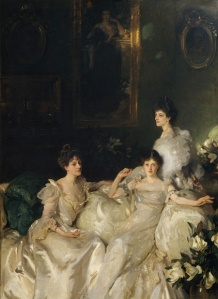
The Wyndham Sisters: Lady Elcho, Mrs. Adeane, and Mrs. Tennant by John Singer Sargent. (Oil on canvas. 1899. Metropolitan Museum of Art.) Not in the Brookly exhibition. (Click to enlarge.)
James would remain an admirer of Sargent for the rest of his life and sat for a portrait himself. But if you needn’t choose between Fry and James on the question of Sargent’s psychological prowess, you can see several of Sargent’s most iconic portraits at the Metropolitan Museum of Art before (or after) the Brooklyn Museum show. The Met has in one room the monumental portraits of Charlotte Burckhardt (to the left above), Mrs. Hugh Hammersley (1892), the Madame X (1893-94), Mr. and Mrs. I. N. Phelps Stokes (1897), The Wyndham Sisters: Lady Elcho, Mrs. Adeane, and Mrs. Tennant (1899) (to the right), the painting which Fry deprecated (quoted above), and Sargent’s friend and fellow portrait painter William M. Chase, N.A. (1902) (together with a monumental Portrait of Whistler by Chase). The gallery offers ample opportunity to evaluate whether Sargent was adept at conveying subtle emotions or overall character.
For my own part, the experience at the Met might raise a different criticism; namely, that Sargent, for much of is life, devoted his considerable gifts to serving the caprices of the wealthy and powerful at a time of particular social inequality and gaudy consumption (a time almost as obscene as our own and dubbed in the United States as “The Gilded Age” by Mark Twain). The psychological truths revealed may be of a particularly narrow range, of the insufferably privileged of Edwardian society, of fops and dandies and overly pampered society women. This charge is rarely leveled against Henry James himself, however, and in any event was not part of Roger Fry’s complaints. And without going at length and putting too fine a point on it, most Western art (as far back as Egyptian tomb reliefs, painting and funerary items) arose from commissions by the very wealthy and concerns the interests of the small ruling class to flatter its self-esteem. Art for and about the rest of us is called either kitsche or folk art.
Sargent’s Major Career Switch
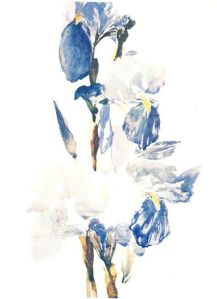
Irises by Edouard Manet. (Watercolor on paper. 1880. Private Collection.) Not in Brooklyn exhibition. (Click to enlarge.)
Sargent painted with watercolors all his life, and he did so seriously with attention to composition and technique. Richard Ormand’s introduction to the exhibition’s catalogue examines the influences on Sargent’s early art, and makes the case that Sargent early studied Manet’s brushstroke technique. Sargent even purchased a watercolor, Irises, at Manet’s posthumous Studio sale in 1885.
Many of the early Sargent watercolors (as well as sketches) are held by the Metropolitan Museum of Art, but they are not currently being displayed. The Brooklyn Museum exhibition, by contrast, is in the main about the watercolors that Sargent painted after he made a decision drastically to scale back on commission portraits, after Sargent had developed his distinctive style in oils. Sargent had long made it a habit to take three months of each year to paint landscapes on the continent. After 1902 he grew more and more restive spending time in his studio. In 1905 he stopped taking commissions on the ground that he could not complete those he already had. By 1909 he had informed no longer painted portraits at all. When pressed persistently, he would occasionally make quick charcoal sketches (as we saw (in another post) he did of William Butler Yeats).
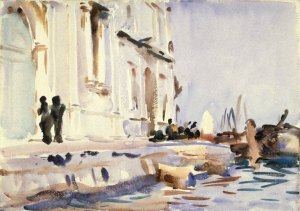
All’Ave Maria by John Singer Sargent. (Watercolor on paper. c1902-04. Brooklyn Museum.) One of many scenes from Venice painted from a gondola. (Click to enlarge.)
Sargent’s watercolors during this period of transition were not a mere avocation or a simple, relaxing pastime. When he travelled abroad, he devoted himself exclusively to painting. By Ormund’s count in three seasons worth of continental jaunts, from 1902 to 1904 when he travelled variously to Switzerland, Spain, France, and different parts of Italy (but always each year to Venice), he produced 230 works, or about one painting per day (including travel). In 1905 while visiting the Middle East in connection with the ongoing “Triumph of Religion” murals, he painted 72 landscapes.
The works were not mere sketches; Sargent worked outdoors for as long as there was light. Nevertheless, given the time constraints, he could not produce works in the same way he did with his studio portraits. Nor did he try. He was not looking to create a study of character. The works did not reveal psychology beneath appearance. In fact, they were as different (in purpose, composition and technique) from his studio work as is the difference between outdoors and indoors.
Most of his 20th century watercolors represents attempts to recreate glimpses or perhaps better, non-critical gazes. They are exercises in showing how the eye takes in a scene. His canvases were designed to tell a story, but his watercolors intended to show a glance, a coup d’oeil. For example, in his portraits (take the The Daughters of Edward Darley Boit, shown above, as an example), the figures are completely modeled with especial attention to the face. The clothing is painted with extreme care, and the objects in the picture are rendered in a way that the viewer can actually study them. Contrast that with the watercolor Florence: Torre Galli.
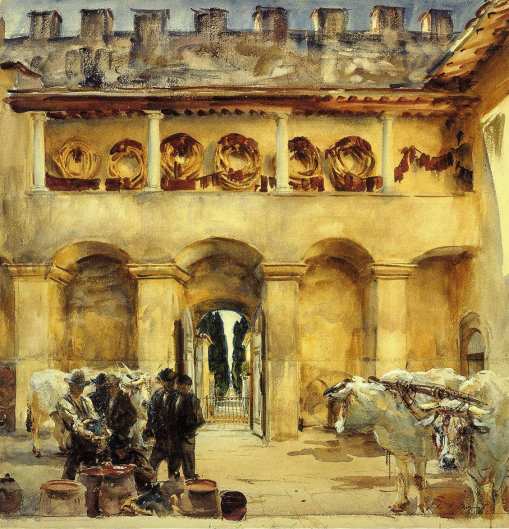
Florence Torre Galli by John Singer Sargent. (Watercolor on paper. 1910. Museum of Fine Arts, Boston.) Click to enlarge.
The work is noticeably larger than most of the other watercolors. It measures 27½ by 26¼ inches compared with the usual work which was just slightly larger than (US) letter size. The larger size allows the work to accommodate two groups in the foreground—the five men to the left and the two oxen to the right—and the balcony on top. If you look carefully at the faces of the men, you will see that they are all essentially blank. To the extent the faces have features at all they are provided by the graphite underdrawing, not the paint. By contrast the face of the ox looking at us (as well as the ropes from the yoke) is completely modeled. A closer inspection of it shows that the effect is achieved by brushing thicker amounts of opaque paint to define the features of the ox’s face. The faces of the men are colored by translucent watercolor. So in this painting the features of the ox’s face appear more important than those of the men. The human faces receive even less detail than the coils of rope on the balcony. The way the objects are rendered shows what is drawing the painter’s attention. He is looking at the oxen to the right, with the rest of the scene taken in by his peripheral vision.

Torre Galli, Wine Bags by John Sargent Singer. (Watercolor on paper. 1910. Museum of Fine Arts, Boston.) Click to enlarge.
Sargent painted the balcony from its side in another watercolor, Torre Galli, Wine Bags. In this case our attention is directed toward the columns and over the balcony. The coiled ropes are not rendered as distinct. And the red-colored skin bags (for carrying wine), which hang from the ropes and litter the floor, are painted as indistinct shapes of color.
The eye can be directed in these paintings by obscuring objects, which can be done either by the manner of rendering or by using wet paper before applying the paint. In the latter case the colors tend to merge without distinct border and the objects become less distinct. The experimental rendering (for Sargent) of objects as indistinct forms, such as in the Torre Galli paintings, is never carried into modernist territory. Objects are not reduced to mere geometric forms, and even when part of a painting is rendered indistinctly another part renders it in visual representation. Nor was he ever interested in abstraction for its own sake. Until the end Sargent believed in the traditional elements of a painting, particularly light. (We’ll see how “realistic” treatment of light can achieve modernist effects.)
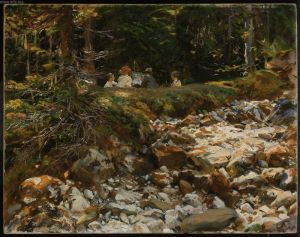
The Master and his Pupils by John Singer Sargent. (Oil on canvas. 1914. Museum of Fine Arts, Boston.) Click to enlarge.
It is striking, however, how many of the watercolors have people with obscured or barely rendered faces. Examples include Bedouin Women (1905-96), Mending a Sail (1905-06) and even the late oil, The Master and his Pupils (1914) (right), a canvas reminiscent in subject matter and technique by his outdoor watercolor work. In that painting the people are off in the distance and facing away from us. It is the canvas we can see, but even that is behind a stream filled with rocks and a riverbank which occupy half of the picturee.

Bedouin Mother by John Sargent Singer. (Watercolor on paper. 1905-06. Brooklyn Museum.) Click to enlarge.
Maybe the most arresting example of Sargent’s intentional obscuring of faces is in the North African painting Bedouin Mother (left). Although the painting is “about” the two figures, neither can be seen. It looks as though a large shadow coming from the left is falling over their heads and shoulders. Only the woman’s lower arms and hands and he baby’s legs can be seen, in front of the lower part of the woman’s robe. The figures are framed by a dark hill in front of a lighter one, both in triangular shapes. The flow of the robe is defined not only by the changes of color but also by broad dark lines, using the same color as the lines and forms (made indistinct by wetting the paper) in the lower background. If the artist were not known, one could be persuaded that it was an early post-impressionist work.
The items in the Exhibition are arranged thematically, not chronologically. This allows us to see how Sargent treated the same or similar material at different times. The major groupings include:

The Bridge of Sighs by John Sargent Singer. (Watercolor on paper. c1903-04. Brooklyn Museum.) Click to enlarge.
- Paintings of Venice. These include some of the earliest works from the Exhibition. They are all painted from inside a gondola. It is the water level (and the water itself) that is emphasized, not the city’s monumental architecture. Paintings are cropped to eliminate the imposing formal parts of buildings (as All’Ave Maria, above). Or the architectural details are minimally rendered as is the face of the famous archway in The Bridge of Sighs (right).

Daphne by John Singer Sargent. (Watercolor on paper. 1910. Museum of Fine Arts.) Click to enlarge.
- Italian Villa Gardens. The subjects of these paintings, which must have evoked Sargent’s nostalgia from his boyhood in Florence and Rome, find stone statuary or columns and vases surrounded by cultivated plants. Usually the stone works are highly defined, illuminated by bright sun. The greenery is usually more abstractly drawn (except, see Gourds above). The very whitest parts of these works represent the paper itself without pigment. At least in the Brooklyn Museum part of these two collections, however, Sargent used no wax resist to protect it and instead relied on careful brushwork.
- The “Bedouin” Paintings. Sargent painted these works during the trips he undertook to research the “Triumph of Religion” murals for the Boston Public Library. Exotic lifestyle and clothing are emphasized.
- Water Craft. Evidently interested in boat craft from early hearing of his grandfather’s business, Sargent painted a series of pictures of water craft from the water level (much like the viewpoint of his Venice paintings). Sargent generally renders the rippling water abstractly and focuses attention on the light as it strikes the white hauls. See Melon Boats and White Ships (both below).
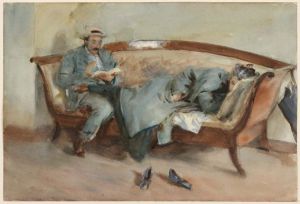
Corfu: A Rainy Day by John Singer Sargent. (Watercolor on paper. 1909. Musuem of Fine Arts, Boston.) Click to enlarge.
- Vacation Scenes. Sargent often vacationed with fellow painters or his niece. During these days he painted scenes of his fellow travelers in intimate settings. In Corfu: A Rainy Day (right), for example, he shows Wilfrid de Glehn reading while his wife sleeps, her feet resting in his lap. In these scenes Sargent has wholly abandoned the dramatic portrait style he perfected.
- Mountain Landscapes. Sargent painted numerous vistas of mountains (usually with quick bold strokes as in Mountain Fire, above) and detailed scenes of streams running over brooks. He used his experiments with color and light to inform oils as well (see The Master and his Pupils, above).
- The Quarry. In 1911 Sargent visited the famous marble quarry above Carrara, Italy, in the Apuan Alps. Fascinated as he was by the reflection of light on stone, he made the quarry the centerpiece of these paintings with the miners small incidental characters. See Carrara: Quarry I and Carrara: Marmo Statuario, both below.
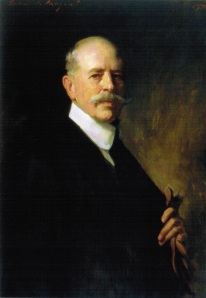
Edward Darley Boit by John Sargent Singer. (Oil on canvas. 1908. Private collection.) Click to enlarge.
In addition to the watercolors the Exhibition contains eight oils by Sargent. Two of them (one of Brooklyn Museum President Aaron Augustus Healy (1907) and one of Edward Darley Boit (right)) are traditional portraits of the men who bought the first collection. The stand in contrast to the free use of light, brushwork and colors that Sargent allowed himself only in works for himself. They perhaps also show that while Sargent had achieved a mastery at this style of portraiture, the energy had left. This may explain why he was so eager to leave the studio and portraits.
The other oils directly relate to the watercolors and Sargent’s new attitude toward his art that his release from commission painting allowed him. There are three “portraits” of artists painting: An Out-of-Door Study (1889), An Artist in his Studio (1903) and The Master and his Pupils (above), all of which show artists painting with a relaxed enthusiasm, something entirely alien to the kind of pandering that Sargent felt he had to do for his plutocratic clients. The two outdoor scenes are visual studies in contours and harmonic colors, things that Fry claimed Sargent had no interest in.
The other final three oils (Dolce Far Niente (above), Head of an Arab (1891) and Val d’Aosta, A Stream over Rocks (c1909) (below), all show how he could transfer the freedom he achieved through watercolors back into oils. The last one might be the most interesting of this group in this regard because Sargent uses oils to paint a translucent scene, the bottom of a stream through running water. He probably attempted to oil to show that his visual acuity, when it came to light diffusing through colors, was such that he was not limited to particular media to achieve a particular visual result.
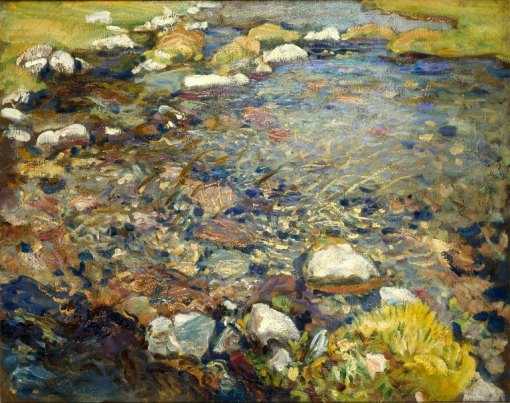
Val d’Aosta (A Stream over Rocks) by John Singer Sargent. (Oil on canvas. c1909. Brooklyn Museum.) Click to enlarge.
Do these Works Add to Sargent’s Stature?
Recently there has been something of a warming in the generally tepid acceptance of Sargent among academics and other arbiters of high culture. Much of this has been owing to the work of Richard Ormond. Of course in our post-modern era, there are no longer generally accepted principles of aesthetics any more than other old-fashioned notions (such as civic responsibility, for example). In looking to experts, it’s always good to keep in mind that there are university courses in the history of television sit-coms and there is a museum dedicated to Norman Rockwell.
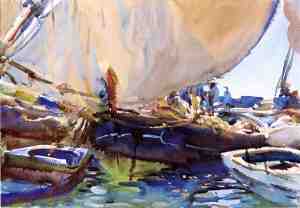
Melon Boats by John Singer Sargent. (Watercolor on paper. c 1905. Brooklyn Museum of Art.) Click to enlarge.
I insert these observations here because many aspects of the watercolors are reminiscent of contemporary commercialized pop pictures (the kind that are found in hotel/motel chains). Of course commercial pop art consumes even acknowledged masters so the fact that our age prefers to recycle rather than create ideas (and refuses to recycle limited resources) should have nothing to do with evaluating Sargent’s century old work.
Roger Fry’s argument, boiled down to essence, is that the best and leading artists of the time began re-evaluating fundamental concepts of art and the relation of the canvas to the viewer. Sargent did not participate in that re-evaluation as radically or in the same tradition as the artists that Fry championed. (It’s worth noting that Fry himself championed principally French modernists. He did not advocate movements from Central Europe or elsewhere. He was a cheerleader for a new way at looking at faces and landscapes. He did not argue that Art should deal with the irrational or the poor. And even in England, his rather limited advocacy failed to re-direct art in the way that Ruskin’s criticism did.)
But it’s not true that Sargent did not engage in experimentation, and he did so relatively late in life. The watercolors offer many examples of how his work veered into new (although not radically new) directions. I choose one aspect here: Sargent’s treatment of light on white.
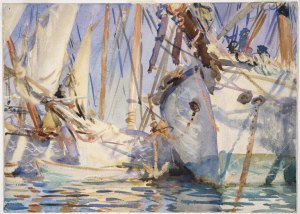
White Ships by John Singer Sargent. (Watercolor on paper. c1908. Brooklyn Museum.) This is the only watercolor from the Brooklyn Museum collection of the Exhibition that shows use of wax resist. (Click to enlarge.)
In Sargent’s portraits the backgrounds are almost always dark. This of course is a convention that goes back as far as light was used to model the figure (and especially the face) portrayed, famously, for example, in Rembrandt’s portraits. The light that is thrown on the figure then defines the features. In Sargent’s case, bright white clothing often helps achieve a dramatic effect especially on large full body portraits. See, for example, The Daughters of Edward Darley Boit (above) and Mr. and Mrs. I. N. Phelps Stokes (1897). In addition, white or near white clothing can be fluffed or wrapped in ways to suggest elegance or other attributes. See The Wyndham Sisters: Lady Elcho, Mrs. Adeane, and Mrs. Tennant, above. In any of these cases the white or lighter pigment is added to the canvas. In Sargent’s watercolors the white is not a pigment, but rather the paper itself. It is the shadow that is cast on the white that Sargent applies. And to do this Sargent applies shadows in broad abstract shapes that intersect, intensifying the darkness, in the reverse of the way light appears to us. The interplay of the white and shadows becomes a two dimension design in itself and flattens the scene.
The “design” effect of the shadows on white is take further in Corfu: Lights and Shadows (below). The shadow of a tree is the central design. And particularly as you look closer, the perspective of the cottage is created only by the color of the shadow.
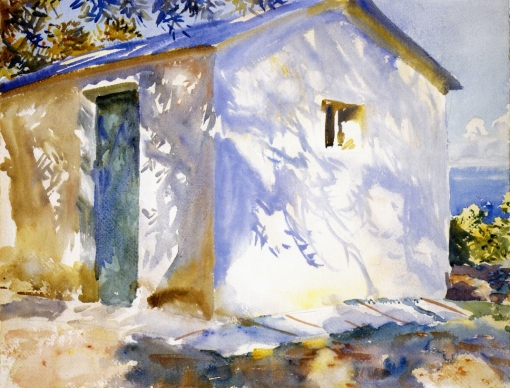
Corfu: Lights and Shadows by John Singer Sargent. (Watercolor on paper. 1909. Museum of Fine Arts, Boston.) Click to enlarge.
The quarry paintings come nearly to being abstract in their use of light and color. The figures of the miners are reduced to the barest minimum.
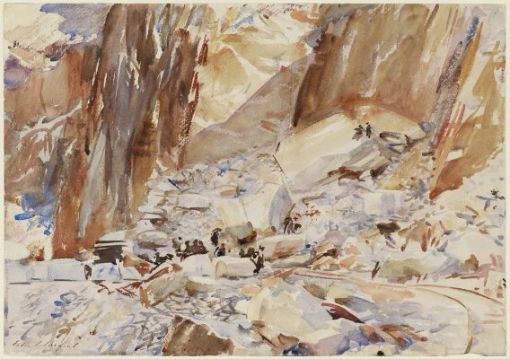
Carrara: The Quarry I by John Singer Sargent. (Watercolor on paper. 1911. Museum of Fine Arts, Boston.)
In Carrara: Marmo Statuario (below) there are no figures and only the title suggest what the subject of the painting is.
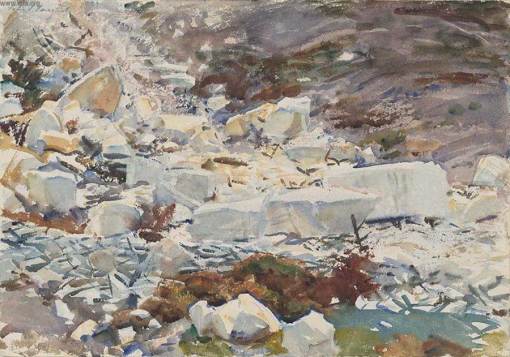
Carrara: Marmo Statuario by John Singer Sargent. (Watercolor on paper. 1911. Museum of Fine Arts, Boston.)
Finally, we reach one of the most interesting works in the Exhibition (especially from the viewpoint of Sargent’s role as innovator), La Blaneria (below). This painting elevates a pedestrian scene, linens drying on a clothesline, into a design of white and muted colors against a green and brown background. The muted colors show how the linens hang from the line but also make a near abstract design when considered simply as patterns. Indeed, there is nothing inherently interesting about the scene, except for the design produced by the shadows.
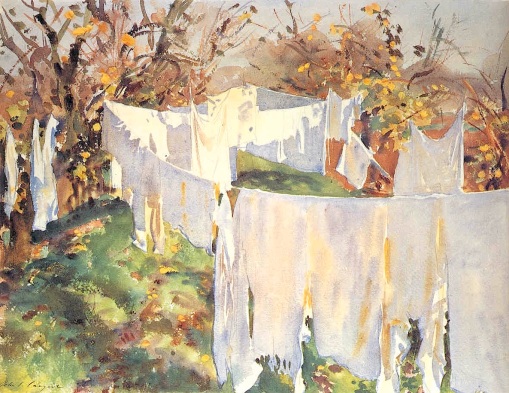
La Blancheria by John Singer Sargent. (Watercolor on paper. 1910. Museum of Fine Arts, Boston.) Click to enlarge.
In a broad sense, Sargent in fact moved in relative conformity with the general trends in the visual arts in the first decade of the twentieth century. He did so slowly and never completely abandoned the representational function he believed art had. Yet, he examined how design, color and contour in themselves made a work of art, even if they also “represented” something real, something that could be seen.
The fact that Sargent did not strictly follow the tradition set out by the French should not particularly matter. Progress in art, no more than descent in evolution, is not a linear matter. And there is no single school or movement that defines the single valid course for artistic inquiry. Sargent rejected the tradition of the French (one that he had never really adopted, and in any event long parted ways with, since the days of Madame X). Yet there was a tradition that he followed and pushed the boundaries of. That tradition was developing across the Atlantic, where Sargent would spend the next phase of his career, and was taken up by such painters as William Merritt Chase, who in turn seems to have influenced Sargent’s own approach to light, and the subjects that produce them, in his watercolors.


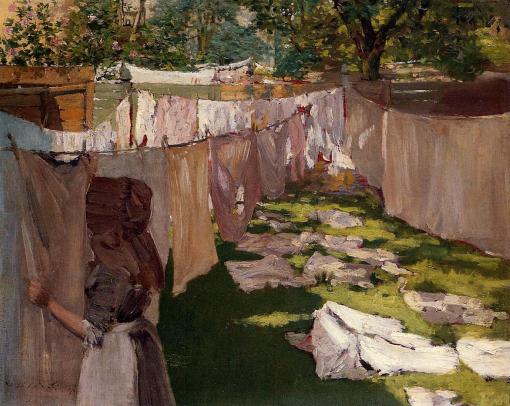
Wonderful and beautiful post on a well deserving subject.. thank you.
Wonderful!
Very well written! You picked a great set of images here. I saw the Brooklyn show and I’m a huge Sargent admirer. I appreciate this post!
Excellent post! I am a huge Sargent fan and I learned a lot from this. Thank you for posting~
Hey, I love watercolors! And these are scrumptious Saw them on your menu. I must read and look over and over again. You’d know what I like best are the scenes of common life, though nothing LOOKS common, even the washings on the line, or The Daughters, as Sargent portrays them. I see that I can mail these images to myself, and I bet that sooner or later one or the other of them will turn up on my own simple blog for “the common blog viewer.”
Exquisite. The play of light. So wonderful!
Fabulous! Thank you for your dedication and obvious love of Sargent’s work.
with the Bedouin Mother painting- the mother and child are standing in a tent. those aren’t hills, they’re the shapes formed by the top and the inside of the tent.
I have just stumbled on your WordPress blog. I love John Singer Sargent’s paintings some of which I have never seen. So, thank you for sharing this wonderful selection of his work.
WOW ! I absolutely love John Singer Sargent”s paintings, sketches water colours, in fact all of his work and would have loved seeing this exhibition but I live much to far away in another country Crete.n Thank you for this wonderful post.